
VOL.10 NO. 4 SPRING 2001
|
Room for a View |
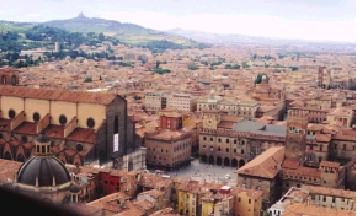 |
|
Reflections on university life from a unique vantage point |
|
|
Story
and photos by Linda Marion
|
The window in my office reveals a slice of the U of U’s upper campus: acacia trees turning gold and a wide spread of lawn dotted with tall pines. The roofs of a neighborhood appear beyond, leading up to the foothills of the Wasatch Range and the big white “U” on the side of the mountain. A dusting of snow covers the mountaintops, and the sky is speckled with popcorn clouds in the wake of the first fall storm. The sun appears from behind a cloud and shoots slivers of light across the sky to illuminate the Oquirrh Mountains across the valley. Outstanding. Steven Spielberg couldn’t have orchestrated it better.
Such spectacular scenes helped draw me back to Utah and, ultimately, to the University, after many years away. The momentary glance from my window invariably takes me back a few years to another office and a different view—one more compressed and crowded, less revealing of the surrounding landscape, but no less awe-inspiring.
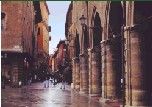 Three
years ago I occupied an office in Bologna, in northern Italy (“about an
hour north of Florence,” I always explain to those who have heard of the
city—thanks to Oscar Mayer—but don’t know where it is). There, my window
overlooked a section of the venerable University of Bologna: no wide green
lawn, no mountains, only the ancient buildings of the oldest university*
in the Western world—900 years and counting.
Three
years ago I occupied an office in Bologna, in northern Italy (“about an
hour north of Florence,” I always explain to those who have heard of the
city—thanks to Oscar Mayer—but don’t know where it is). There, my window
overlooked a section of the venerable University of Bologna: no wide green
lawn, no mountains, only the ancient buildings of the oldest university*
in the Western world—900 years and counting.
Bologna is the original university town. The city is known as
la grassa, la bella, e la dota (“the fat,” because one eats well;
“the beautiful,” an acknowledgment of its attractive women; and “the learned,”
a reference to its world-famous university). I was fortunate to have lived
and worked in Bologna for 15 years. My Italian sojourn proved to be the
quintessential life-altering, horizon-broadening experience. It convinced
me that the world would be a better place if everyone had the opportunity
to live for a time in a culture not one’s own—communicating in another
language, observing and participating in local traditions, and being exposed
to different values, priorities, and points of view. 
Bologna is a city of 500,000 inhabitants, about half of whom are crowded into its historical center, an area roughly twice the size of the U of U campus. The city’s origins are Etruscan; the Romans followed a few centuries later. Medieval Bologna eventually took shape atop Roman ruins, which are invariably revealed with every excavation. It’s no place to break a water main.
Once protected by high stone walls, the city center is now encircled by a four-lane highway, which still acts as protection from “foreign invaders,” only today’s disincentive to entry is speeding cars instead of spears. Apart from coping with Italians’ legendary driving habits (it wasn’t always easy living in a country whose citizens insisted on defying the basic law of physics that states two masses cannot occupy the same space at the same time), I found life in Bologna comfortable and forever fascinating. Known as the “capital of Italian cuisine,” Bologna offers fabulous food, few tourists, friendly, if somewhat reserved, inhabitants, an abundance of astounding works of art and architecture, and 35 kilometers of porticoes that crisscross the city, protecting its citizens from the elements.
Bologna is therefore the most walkable of cities, and one of Italy’s most captivating—although few tourists know it, opting to invade the more high-profile Florence, Rome, and Venice. Wandering through the town’s narrow side streets is like touring a stage set constructed of timbered and tiled porticoes, marble facades, leaning towers, terra-cotta tiled roofs, and stucco walls painted earth colors— ochre, umber, and mauve—that radiate a ruddy glow in the afternoon light.
From spring through fall, the air is warm and moist, yet underneath the porticoes and inside the many basilicas, the atmosphere is cool and tinted blue. It is a city of startling contrasts, and almost impossible to photograph.
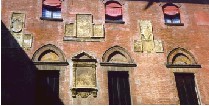 I
used to walk (or bike) to work every day, passing by the university’s
administrative offices to get to my own a ways down the street. I often
glanced up for a peek inside the upper-story windows and was rewarded
with snatches of frescoed ceilings and cascading chandeliers.
I
used to walk (or bike) to work every day, passing by the university’s
administrative offices to get to my own a ways down the street. I often
glanced up for a peek inside the upper-story windows and was rewarded
with snatches of frescoed ceilings and cascading chandeliers.
Understandably, Bologna’s university is imbued with a great sense of its role in the history of academe. In 1988 it celebrated its 900th anniversary with a yearlong festival. The year was marked by a great deal of pomp and more circumstance than even Edward Elgar could have imagined. Headed by Il Magnifico Rettore, the Università degli Studi di Bologna, or the “U of Bo,” as it is affectionately known among English speakers, enrolls about 90,000 students a year. (And we think the U has parking problems?) Not surprisingly, the vast majority of students studies at home, making occasional forays to the university to consult with faculty advisors or to attend lectures.
The large enrollment is a result of Italy’s student riots of 1968 and
the subsequent installation of an exceedingly egalitarian educational
system. Anyone who graduates from high school (liceo) is eligible
for university admission. And except for a modest administrative fee,
there is no tuition. Not all who enroll, however, succeed in graduating;
many drop out along the way. Those who do achieve their laurea,
following a rigorous set of oral exams and a thesis to boot, are referred
to as dottore. 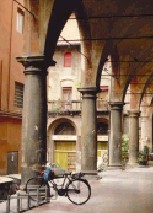
To say that the University of Bologna has produced some impressive scholars would be a supreme understatement. The alumni rolls comprise a veritable “Who’s Who in the History of Law, Arts, and Sciences” and include such high achievers as Dante, Petrarch, Copernicus, Galvani, and Erasmus, to name a select few. (Women scholars were rare, but by the 12th century they were permitted to teach, although with restrictions. Fourteenth-century female teacher Novella d’Andrea, for example, reputedly wore a veil in the classroom in order not to distract the students with her beauty.)
In addition to being illustrious, the university’s alumni rolls are extensive. Graduate records alone could fill up a coliseum. This, of course, raises a question: How does one keep track of 900 years’ worth of alumni? Answer: One doesn’t. While Italian traditions run deep, there is no institutionalized practice in the country’s public education system of maintaining contact with graduates. That means there are no university alumni associations and therefore no university-affiliated booster clubs, no homecoming, no football or basketball teams, no cheerleaders, no mascots, no fight songs, no rah-rah whatsoever. (Such sports-induced excitement, bordering on mass hysteria, is reserved for Italy’s regional soccer clubs.)
No, Italians are not called upon to support the home team by huddling in a football stadium on a freezing fall afternoon, sporting school colors, waving pom-poms, and belting out fight songs. Nor are they asked to raise scholarship funds for students, sit on advisory boards, organize local alumni chapters, donate to food drives, or make annual contributions in support of worthy college initiatives. Once an Italian student has closed the doors of a university’s hallowed halls, he or she rarely looks back.
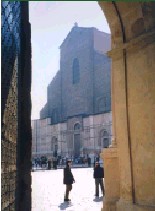 For
better? For worse? Neither, really—no call to judgment is required. European
educational systems are just, well, different. It could be argued, if
one were inclined, that a European university education is more pure;
that is, the university exists solely to educate and/or to promote research.
Because higher education in continental Europe is almost entirely publicly
financed, there is no need to fundraise or to call on graduates to support
university programs. Citizens have already “contributed” through taxes
high enough to choke an American. Collegiate fundraising is, therefore,
a concept utterly foreign, if you will, to Europeans. On the other hand,
the American semi-publicly funded higher educational system—with
its attendant alumni associations, booster clubs, annual funds, community
service programs, sports rivalries, marketing of collegiate paraphernalia,
and, yes, publications—creates a strong sense of identity among university
graduates as well as a collegial spirit within the local community.
For
better? For worse? Neither, really—no call to judgment is required. European
educational systems are just, well, different. It could be argued, if
one were inclined, that a European university education is more pure;
that is, the university exists solely to educate and/or to promote research.
Because higher education in continental Europe is almost entirely publicly
financed, there is no need to fundraise or to call on graduates to support
university programs. Citizens have already “contributed” through taxes
high enough to choke an American. Collegiate fundraising is, therefore,
a concept utterly foreign, if you will, to Europeans. On the other hand,
the American semi-publicly funded higher educational system—with
its attendant alumni associations, booster clubs, annual funds, community
service programs, sports rivalries, marketing of collegiate paraphernalia,
and, yes, publications—creates a strong sense of identity among university
graduates as well as a collegial spirit within the local community.
What does this all mean? For my part, it means that I am pleased to be an active member of the U of U community once again, and on the staff of the Alumni Association, even if it does include wearing red (previously not my favorite color) once in a while, and working up some enthusiasm (formerly lacking) about football and basketball competitions. Go Utes.
Most important, I am grateful for the opportunity to observe and record the goings-on in the neighborhood. Even though it has been around for a mere 151 years, the University of Utah has a fascinating history and an impressive record of achievement. It’s a stimulating environment, and an attractive one to boot.
So, here I am, periodically peering out the window to track the sun’s progress across the sky, succumbing to the occasional sniffle over what I left behind, but feeling fortunate indeed to have the opportunity to watch the future Copernicuses, Dantes, Petrarchs, and Erasmuses (male and female) trek up and down the hillside and across the wide green lawn.
* While it is not possible to know for certain whether the requisites for establishment of a university, as we know it, existed in the 11 th century, 1088 has been accepted as the conventional date when teaching became free and independent of ecclesiastic schools in Bologna. It was towards the turn of the 11 th century, in fact, that masters of grammar, rhetoric, and logic began to study law in Bologna.
—Linda Marion BFA’67 MFA’71 is managing editor of Continuum.
Continuum
Home Page - University of Utah Home
Page - Alumni Association
Home Page
Table of Contents
Copyright 2001 by The University of Utah Alumni Association